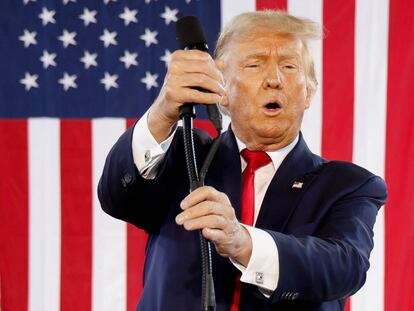How the Republican Party broke into pieces
The ouster of Kevin McCarthy, the speaker of the House of Representatives, highlights how the group has become entrenched in a ‘civil war’ between traditional conservatism and Trumpism


Last week’s spectacle in which the U.S. House of Representatives ousted its speaker for the first time in 234 years — thanks to an alliance between the Democrats and eight far-right Republicans — did not only merit the much-used adjective of “historic,” it also reconfirmed the fracture of the conservative movement in the United States. Even Donald Trump pointed to this problem on his social network Truth Social: “Why is it that Republicans are always fighting among themselves, why aren’t they fighting the Radical Left Democrats who are destroying our country.”
The drama over the ousting of Kevin McCarthy as House speaker unfolded before a public that was both fed up and resigned to the political class. Trump’s question was his only contribution to the debate about Republican infighting. The former U.S. president was busy with more pressing matters in New York, where he appeared in a civil fraud trial. And many analysts in Washington would agree on the answer: the divisions seen these days on Capitol Hill largely stem from Trump’s rise in politics, his four years in office, and the months that passed between his defeat in the 2016 election — which he still refuses to concede — and the attack on the Capitol, a period in which he is facing two indictments.
After initially staying silent, Trump — who is the front-runner to win the Republican Party’s 2024 presidential nomination — has once again flipped the script. First, he proposed running as a temporary speaker, until party unity was restored. Then, he threatened to appear next week in Congress, where the circus of electing a new speaker will get underway on Tuesday. And finally, he threw his support behind Jim Jordan, a congressman from Ohio, over the other serious candidate for the speakership, Steve Scalise (Louisiana), who was McCarthy’s second in command and is undergoing chemotherapy for multiple myeloma.
A victory for Jordan would show that Trumpism has well and truly taken over Lincoln’s party and all but guarantee a legislative paralysis on Capitol Hill, where Democrats control the Senate. Jordan is one of its most radical Republicans in Congress. His former colleague Adam Kinzinger said he belonged to the camp of “Christian nationalists where he believes he is truly fighting these dark forces and the Constitution in some cases is an impediment to him being able to fight those forces.”
Jordan helped found the Freedom Caucus, a group that emerged in 2015 from the conviction that the speaker at the time, John Boehner, was not fighting hard enough in the budget negotiations with the Obama administration. The Freedom Caucus includes six of the eight fractious Republicans who, led by Florida Rep. Matt Gaetz, voted on Tuesday to take away their party’s legislative power rather than accept the concessions agreed to by McCarthy to avoid a partial government shutdown. The result of those efforts was a stopgap spending bill, which will expire on November 17.
“Fratricidal twins”
The six Republicans are all Trump loyalists; they represent the voter base that will support the former president no matter what. The Republicans — a party Theodore White famously defined in the 1960s as a party of “fratricidal, not fraternal, twins” — need these voters to win the election. And this voter base is angry, says political scientist Wendy Brown, because they believe they have lost their place in the world due to the advance of minority rights, globalization and rise of institutions.
For these voters, the very idea of Washington is offensive. It’s considered a swamp that needs to be drained of political corruption and the complacency of traditional Republicanism, as represented by figures such as McCarthy or Republican Senate leader Mitch McConnell. Politicians who fall into this category are disparagingly referred to by the acronym RINO — Republicans In Name Only.
The ouster of McCarthy — which Rich Lowry, editor of the magazine National Review, the intellectual organ of the moderate right, consider to be “an indication of an even wilder phase of Republican politics to come” — brings an end to the generation of conservative leaders that emerged in 2007. This group was inspired by Reaganism, and presented themselves as the “Young Guns” in a book authored by McCarthy, Eric Cantor and Paul Ryan. In the book — which borrowed the name of a 1980s western — the politicians laid out their vision to transform the Republican Party, which involved recovering ideals such as “economic freedom, limited government, the sanctity of life [against abortion] and putting families first.” “This isn’t your grandfather’s Republican Party,” said publicity material at the time.
Young Guns emerged just as the Tea Party — a movement that had even less in common with “your grandfather’s Republican Party” — was also starting to take off. And it was this populist tide that would bring an end to McCarthy, the head of the Young Guns. After the first attempt to reach Washington via vice presidential hopeful Sarah Palin failed, Trump brought many of those ideas to the White House, and they are now deeply embedded in the party.
But according to journalist David Corn, who writes for the leftist Mother Jones, one has to go back even further to find the moment when the Republican Party “went crazy.” In his book American Psychosis, he argues that this Faustian bargain with “far-right radicals, bigots, fundamentalists, and kooks” is an invisible line that runs from Senator McCarthy’s witch hunts through the anti-Communist conspiracists of the John Birch Society to Newt Gingrich’s 1990s conservative revolution. According to Corn, if there is one thing that unites all of these cases, it is that the party has nurtured its relationship with the far right by “recklessly and relentlessly stoking the paranoia, fear, resentments, and grievances of conservative voters.” For Corn, the paroxysm of this trend is the attack on the Capitol.

Last Tuesday, after McCarthy’s was ousted as speaker, plunging Congress into chaos, Tim Burchett (Tennessee), one of the eight Republicans who voted against him, sat on the steps of the main entrance to the Capitol. With a defeated expression, he explained that he had no choice but to vote against McCarthy: “My conscience was telling me that he needed to go.”
Meanwhile, after a display of cohesion uncommon in the Democrat Party’s recent history, Maryland Democratic Representative Jaime Raskin said in a statement: “With complete unity and exceptional leadership, Democrats are clearly the only party capable of governing in the House, and [Hakeem] Jeffries is clearly the best candidate for speaker and for the stability and progress of the institution.”
Jeffries is the leader of the Democrat Minority Leader in the House. Last week, he did not miss a single opportunity to describe McCarthy’s ouster as part of a “Republican civil war.” For his part, President Joe Biden has called for an end to the “poisonous atmosphere” in Washington, perhaps relieved to see that the chaos on Capitol Hill was drawing attention away from his disastrous management of the border crisis and criticism over his decision to authorize more border wall construction.
It is highly unlikely that Jeffries will be elected House speaker: he would need 218 votes, and the Democrats only have 212. Nor does the prospect of a Republican bloc vote seem clear at this point. On Wednesday, both parties will begin the process of choosing a new speaker. They will vote until a candidate prospects. The last speakership vote took place in January: it required an unprecedented 15 rounds, and the candidate elected only lasted nine months. Until a new speaker is elected, the position of third-highest authority in the country and second in the presidential line of succession will remain vacant.
Sign up for our weekly newsletter to get more English-language news coverage from EL PAÍS USA Edition
Tu suscripción se está usando en otro dispositivo
¿Quieres añadir otro usuario a tu suscripción?
Si continúas leyendo en este dispositivo, no se podrá leer en el otro.
FlechaTu suscripción se está usando en otro dispositivo y solo puedes acceder a EL PAÍS desde un dispositivo a la vez.
Si quieres compartir tu cuenta, cambia tu suscripción a la modalidad Premium, así podrás añadir otro usuario. Cada uno accederá con su propia cuenta de email, lo que os permitirá personalizar vuestra experiencia en EL PAÍS.
¿Tienes una suscripción de empresa? Accede aquí para contratar más cuentas.
En el caso de no saber quién está usando tu cuenta, te recomendamos cambiar tu contraseña aquí.
Si decides continuar compartiendo tu cuenta, este mensaje se mostrará en tu dispositivo y en el de la otra persona que está usando tu cuenta de forma indefinida, afectando a tu experiencia de lectura. Puedes consultar aquí los términos y condiciones de la suscripción digital.
More information
Archived In
Últimas noticias
Welcome to the post-religion era: The idea of Christianity as the absolute truth has become obsolete
‘I thought you would like it’: The risky sexual practice popularized by TV shows and TikTok
The digitalization of tourism: ‘They promise experiences and gave us the worst possible one’
Mexican peso defies uncertainty with forecasts of a new period of stability in 2026
Most viewed
- Sinaloa Cartel war is taking its toll on Los Chapitos
- Reinhard Genzel, Nobel laureate in physics: ‘One-minute videos will never give you the truth’
- Oona Chaplin: ‘I told James Cameron that I was living in a treehouse and starting a permaculture project with a friend’
- Why the price of coffee has skyrocketed: from Brazilian plantations to specialty coffee houses
- Silver prices are going crazy: This is what’s fueling the rally










































